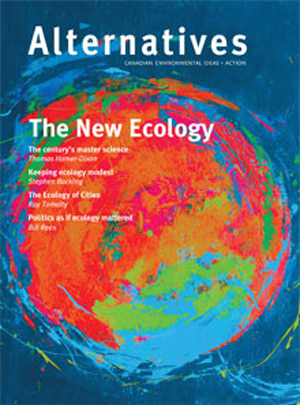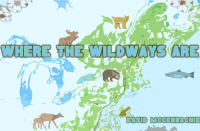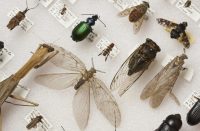Now on newsstands
Is ecology the “master science” of the 21st century? Thomas Homer-Dixon argues that it could be society’s new dominant science, just as physics was in the 20th century.
In this issue of Alternatives, we take a deep look at The New Ecology, with articles from Bill Rees, Stephen Bocking and David Suzuki Foundation CEO, Peter Robinson, among many others.
Now on newsstands
Is ecology the “master science” of the 21st century? Thomas Homer-Dixon argues that it could be society’s new dominant science, just as physics was in the 20th century.
In this issue of Alternatives, we take a deep look at The New Ecology, with articles from Bill Rees, Stephen Bocking and David Suzuki Foundation CEO, Peter Robinson, among many others.
 Read selected articles and web extras from this issue
Read selected articles and web extras from this issue
Here’s what else you get when you buy the issue:
Letter From the Classroom – Tegan Renner
One Classroom at a Time
News & Notes: 35.4
The Ecology of Cities – Ray Tomalty
Urban planners are starting to see cities as complex systems that ought to be conceptualized in a way that mimics natural processes. Steve McPherson’s Statement
Oceans of Neglect – Jennifer Lash
Add some political will, and Canada could be protecting its marine areas. Safer Waters, More Babies
Mighty Small – Jessica C.Y. Wong
Examining microscopic creatures will improve our understanding of the ecology of our planet.
Buddies in Bad Times – Heather English
Mycorrhizae play an important role in helping plants adapt to a changing climate.
Not Just a “Bloody Swamp” – Nathan Vadeboncoeur
Inclusive dialogue and co-operation opened the door to preserving Manitoba’s Brokenhead Wetland.
Be the Government
Nicola Ross Linda Duncan, the only NDP MP from Alberta, is probably the strongest environmental voice in the house.
In Review: Still to Come – Peter Robinson
Carbon Shift by Thomas Homer-Dixon
Brain Mulch: Green Enough? – Ryan David Kennedy
Daddy, what did YOU do to make the community more sustainable?
Publication of this issue was made possible by The Gosling Foundation; The Salamander Foundation; and the support from our many subscribers. We acknowledge the financial support of Canada’s International Development Research Centre (www.idrc.ca); EJLB Foundation; Friends of the Greenbelt Foundation; The McLean Foundation; Ontario Media Development Corporation; Ontario Trillium Foundation; Ontario Work Study Plan. We acknowledge the financial support of the Government of Canada through the Canada Periodical Fund (CPF) of the Department of Canadian Heritage toward our project costs. The support of the Faculty of Environment at the University of Waterloo and the Waterloo Environmental Studies Endowment Foundation is appreciated.’






 Read
Read






